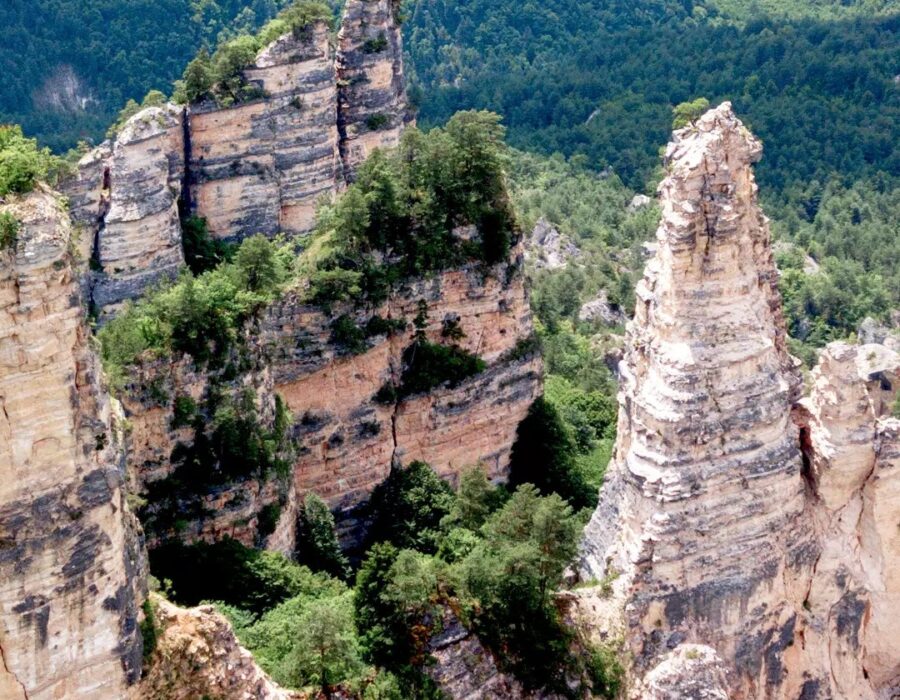Georgia, “Sakartvelo” – Ancient civilization of the world, is one of the fastest developing and growing tourist regions. Its territory has everything – beautiful mountains and waterfalls, natural mineral waters, transparent springs, the sea, alpine lakes, large and deep canyons, botanical gardens, caves. Here you will see footprints of dinosaurs, cover of endemic vegetation and forests, state reserves, protected areas that are included in the World Heritage List. All this with several hundred natural and historical monuments leaves an indelible impression on visitors and causes their sincere admiration.
About Georgia
Georgia is located in the Caucasus, between the Black and Caspian Seas. Its territory is about 70 thousand square kilometers, the population is up to 5 million. Georgia is predominantly a mountainous country. On its territory is the highest part of the Greater Caucasus. The shortest sea and land routes to many countries of the world pass through Georgia. Our small Christian country, which connects Europe and Asia, is famous for its centuries-old history, an abundance of cultural and historical monuments,beautiful nature, delicious food, fine wines, rich original culture and traditions. Courageous, gifted, peaceful, sincere and hospitable people live in Georgia.
Many people know the ancient Greek legend about the campaign of the Argonauts in the fabulous Colchis for the Golden Fleece. The Golden Fleece is a symbol of the wealth and power of Georgia (Colchis). Back in the 6th century BC. the first Georgian state already existed – Colchis and after it – Iberia. That’s what the ancient Greeks called it. Rich Colchis was known in the centers of European culture of that time. This is evidenced by the written sources of Greek historians, writers, travelers and scientists from different countries.
Georgia is an Orthodox Christian country, which was one of the first to adopt and declare Christianity at the beginning of the 4th century as the state religion. There are 4 UNESCO World Heritage Sites on the territory of the country, and 16 sites on the territory of Georgia are among the candidates for inclusion in the World Heritage List. Bolnisi Sioni, Vardzia, Uplistsikhe and other objects entered the treasury of world architecture.
5 ancient artifacts from Georgia changed the world:
- On the territory of our country in the 90s of the last century, a real sensation was found – female and male bones, whose age was about 1.8 million years. Scientists named the new species Homo Georgicus (“Georgian man”) and proved that these are the oldest representatives of the Homo genus after those found in Africa and this means that European civilization originates precisely in Georgia, i.e. Georgia is the birthplace of the European.
- Earthenware jug (“Qvevri”) VI millennium BC. from central Georgia with the remains of wine stones proved that Georgia is the birthplace of winemaking. Already 8 thousand years ago, our ancestors managed to invent winemaking. Mankind has somewhat modified the original method of winemaking, and we in Georgia, having preserved traditions, continue to make wine in the same way as our ancestors. Thanks to this, our traditional winemaking method is included in the UNESCO Intangible Heritage List.
- Tunnels were opened 50 km from the capital of Georgia, Tbilisi, in which ancient miners mined gold. Scientists determined the age of the workings – IV millennium BC!!! Today, these are the oldest gold mines in the world, even older than those of Egypt. Numerous artifacts were also found in the tunnels: pottery and tools. This means that the world’s oldest gold mines, which are 6 thousand years old, are Georgian.
- Metallurgy and blacksmithing – 5 thousand years. – When it comes to the place where metallurgy was invented, archaeologists vaguely call Asia Minor and India, where at the turn of the II-I millennium BC. iron tools were already in full use. But the Bible clearly states that the inventors of metallurgy and blacksmithing were representatives of the ancient Georgian tribe of Tubals! And only then the outstanding products of Georgian masters were sold to connoisseurs from Assyria, Mesopotamia, and Greece. This theory can also be traced in myths: the hero of the ancient Georgian epic hero Amirani (who, by the way, is the prototype of Prometheus) – the son of the goddess of hunting Dali and a mortal man – taught
people to forge iron. There are also toponymic confirmations – for example, the name of the town Sarkine, which is translated from Georgian as “a place of iron.”
- The world’s first thread – 34 thousand years. – Somewhere in the Upper Paleolithic era on the territory of today’s Western Georgia, a man invented a thread. It would seem an ordinary invention, but it changed a lot, allowing our ancestors to weave and mend clothes, create shoes and surround themselves with simple interior items. In general, one more step into modern civilization, which mankind has made on the territory of our country. Before this discovery, the most ancient thread was considered to be a nettle found in the Czech Republic. But the Georgian linen thread, discovered in 2007 in western Georgia, Imereti, is almost 5 thousand years older!
Very soon, this “five” can be replenished with two more points: not far from the resort of Borjomi, archaeologists have found the burial place of the first beekeeper on earth with vessels in which honey of 3 different types was preserved. The age of honey is 5.5 thousand years – and this is more than 2 thousand years older than the oldest honey, which was found in the tomb of the Egyptian pharaoh Tutankhamen.
Georgia is also a contender (together with Italy) for the title of “Motherland of Cheese”.
There are also interesting facts from the history of Georgia’s development.
In the XI-XII centuries, there were two academies in Georgia – in Gelati and Ikalto, and even earlier – a philosophical school in Fazisi (the current city of Poti). Scientific centers of Georgian culture also existed abroad – in Greece, Syria, Palestine, Bulgaria. It was these centers of culture that contributed to the development of national culture, science, and philosophy in the 11th-12th centuries.
Georgian writing was created in the 3rd century BC by the king of united Georgia, Parnavaz. There are only 14 scripts in the world and one of them is Georgian. The first monument of Georgian fiction “The Martyrdom of Shushanik” by Jacob Tsurtaveli was written in the 5th century. The poem of the brilliant Georgian poet Shota Rustaveli “The Knight in the Panther’s Skin”, which was composed in the 12th century, entered the treasury of world fiction.
The history of Georgia is the history of the centuries-old struggle of the Georgian people with their countless enemies. The Georgian people have always fought for survival, freedom, and independence. For thousands of years, the best national traits of Georgians have been forged: patriotism, knightly prowess, fidelity in friendship, hospitality, poetic soul, etc.
XI-XII centuries is a brilliant period of flourishing of Georgian national culture and history. This is the period of the reign of the most revered Georgian king David the Builder (Agmashenebeli) and his great granddaughter Tamar. Tamar is the only woman in the world – the ruler who bears the title of king and not queen. She entered the history of Georgia as “King of Kings Tamar”. During her reign, Georgia occupied a vast territory, but now most of it with numerous Georgian architectural and cultural monuments falls on the territory of other countries.


